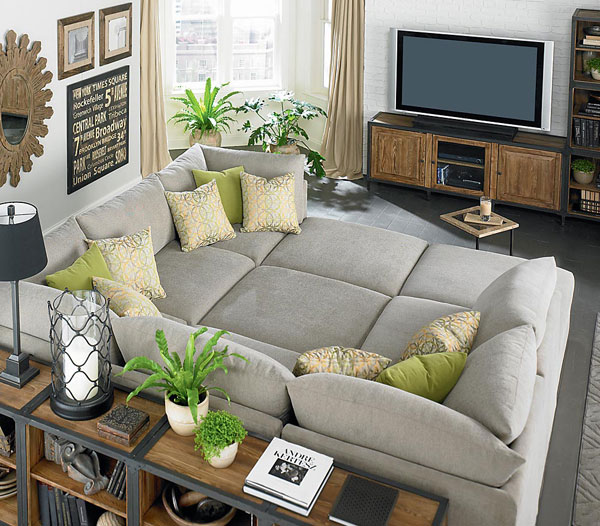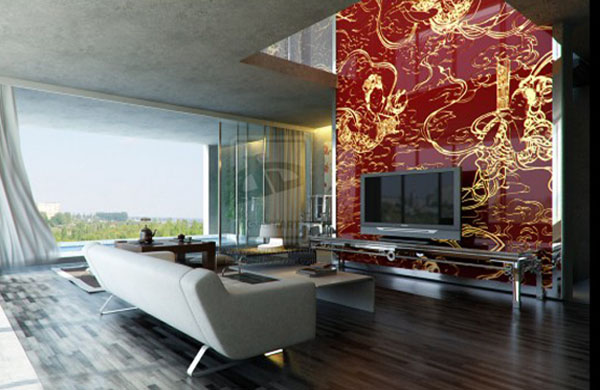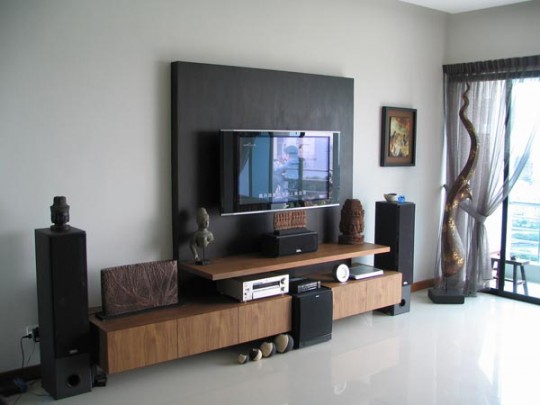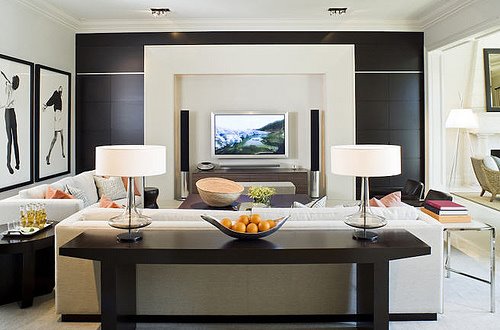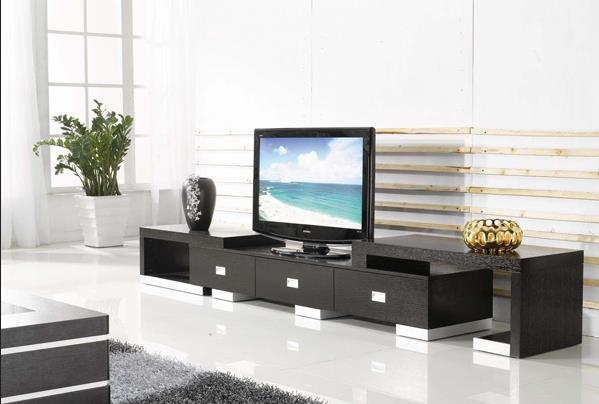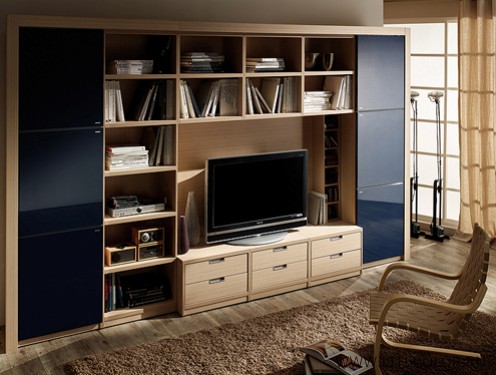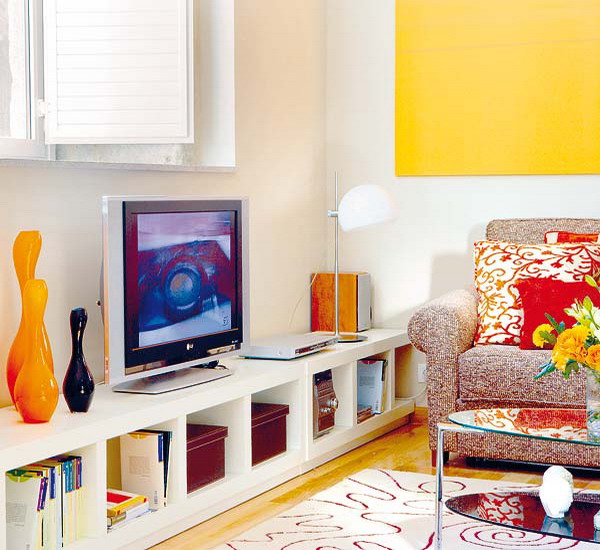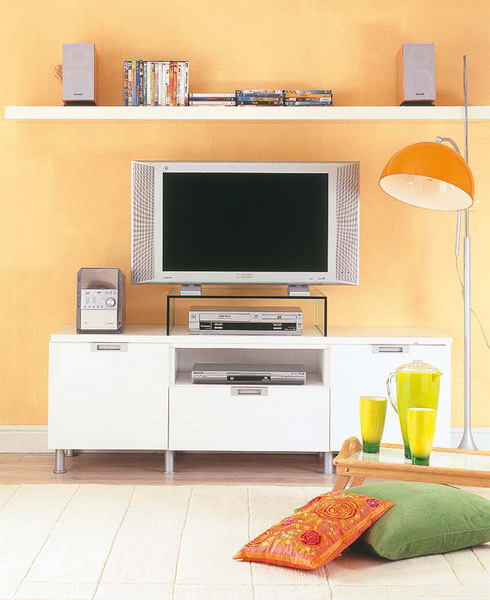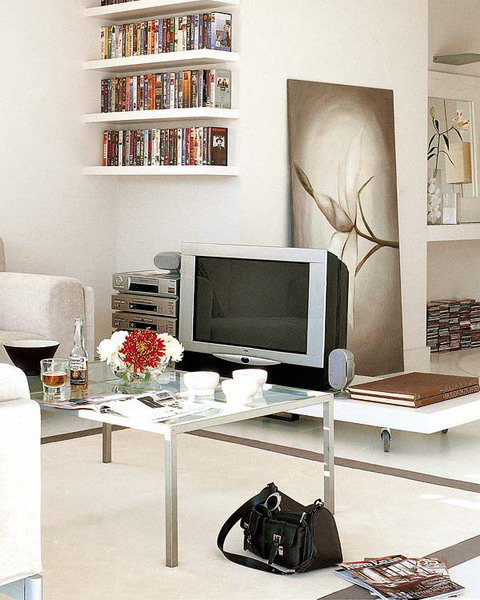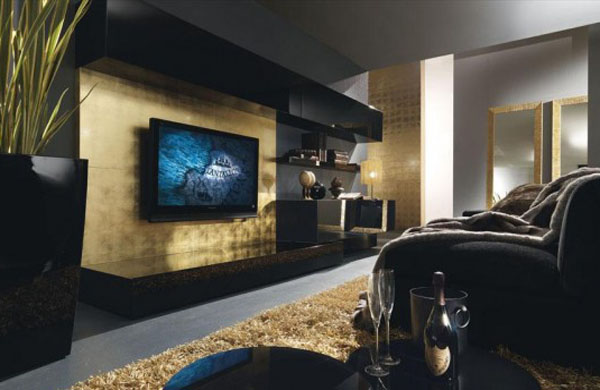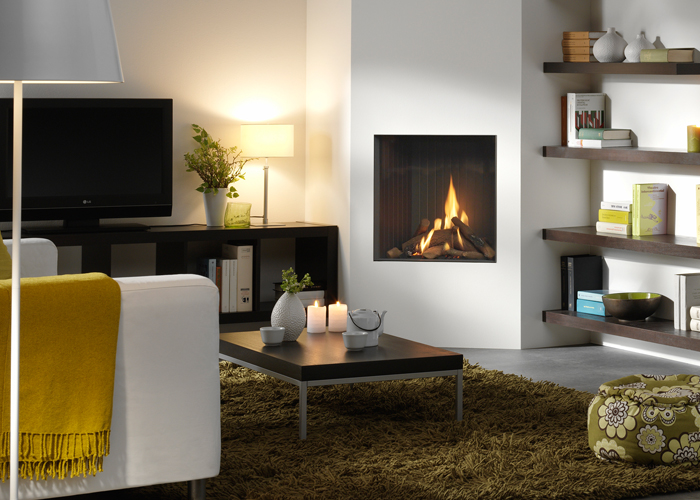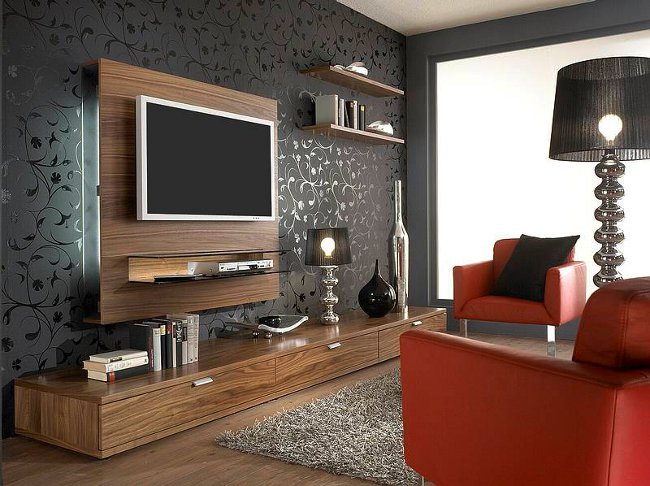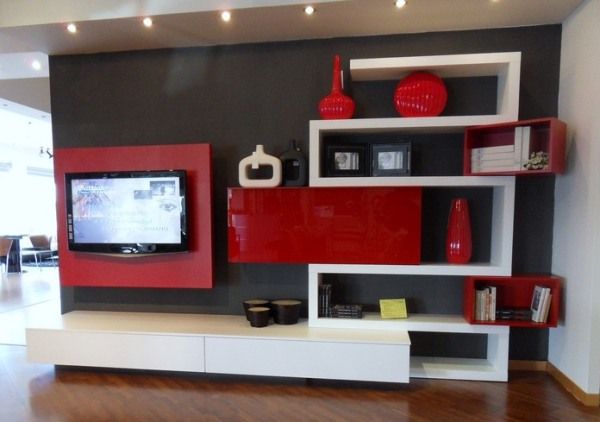TV in the corner near the window. It is clear on how to choose and place TV in the living room
In modern homes, TVs are in almost all rooms. And, of course, I would like them to fit well into the interior, supporting the design of the premises, and also allowing people to conveniently stay while watching movies and TV shows. A lot of people, making a house rearrangement, think about how to properly position the TV. Of course, much depends on personal tastes. But, nevertheless, there are a number of rules, following which you can ensure yourself the most comfortable viewing conditions, and also make this subject a real room decoration.
How to arrange a TV in the living room
The very first thing you need to worry about is the functionality of the TV. Regardless of your design preferences, the TV should be placed so that the sun does not fall directly on the screen and the light from the lamp. This means that the TV can not be placed in front of the window. And making fixtures in the room, you need to take care that in the area where the TV is, there was not very bright lighting. It is best to use lamps with light bulbs not more than 40 W. This will allow you to create the effect of a movie theater and at the same time not to harm your vision with total darkness.
What should be the distance from the TV set to the sofa? The most optimal for viewing television shows is the distance from the screen to the viewer, equal to 2-3 diagonals of the screen. If you plan to install a 32-inch TV set, set the sofa 2 m from the TV. If you want to take a larger screen, then the distance should be correspondingly larger. For a 46-47-inch TV, you need a distance of 3 m, and for a 60-inch diagonal screen you need 4 m. It's not worth putting a huge TV in a small room. Believe me, you will not get any pleasure from watching movies on such a big screen.
At what height do you put the TV? If we assume that the viewer will sit in the chair, then the optimal positioning of the television set is that the center of the screen is 0.8-1.4 m above the floor. It is very important that there is enough free space around the screen. In addition, reflecting on how to arrange the TV in the living room, you must also decide on the layout of the components of the audio system. You need to find a place for the front side speakers (on both sides of the screen at a distance of 90-100 cm), a subwoofer (on the right or left of the TV), a center speaker (below the screen clearly in the middle) and rear side speakers (behind the viewer, in mirror reflection front side columns). The height of the audio system should be determined in such a way that the tweeters' high-frequency speakers are at the ears of the viewer.
After determining the location of the TV, you need to choose how to install it. If before, most people preferred to install the TV on the bedside table or stand, now it is more popular to mount the TV on the wall. This allows you to significantly save space by removing excess furniture and "lightening" the interior. Now people no longer make the main decoration of the room from the TV, they are on the contrary trying to hide the presence of technology, playing a flat screen in the form of a picture or a mirror, neatly inscribing it between the bookshelves and other elements of the decor. Also, wall-mounted liquid crystal panels solve the problem with where to place the TV in the kitchen. After all, the kitchens are often so small, and there are so many household appliances in them that there is not room for a TV.
How to place the TV on the wall
In order to place the TV on the wall, you need to purchase a special mounting plate or bracket. It can be designed to rigidly fix the TV without the ability to rotate the screen, or to a flexible mount that allows you to change the position of the screen in space. The swivel bracket, of course, is more expensive, but it is more convenient. In addition, when buying a fastening panel it is important to consider the weight of the TV. And before you place the TV on the wall, you need to make sure that it will withstand the weight of the whole structure. For example, experts do not recommend to hang a TV weighing more than 30 kg on a drywall wall.
You only need to connect the cable to the TV after installing it. And be sure to make sure that when you turn the screen cable is not stretched. This can be dangerous in terms of sparking and ignition. Another important point to which you need to pay special attention is good ventilation of the TV. If you place it in a closed niche, it can sometimes overheat and fail.
Having dealt with the complexity of the installation, you need to think about how to arrange the TV in the room so that it fits perfectly into the interior. Here a lot depends on the layout of the space, as well as on the design of the room. Now it is very popular to build TVs into furniture. Almost all modern cabinets assume a separate space for the TV. It can be a large central niche between vertical side racks, or a small niche on the side, adjacent to the bookshelves.
Also, the TV can be hung on an open wall, effectively decorating the surrounding space. The area around the TV can be identified with a plasterboard or a contrasting color. It is believed that the best background for the TV is a soft, one-tone paint of a pleasant shade that does not detract from the screen. Although many people paint the area around the TV quite brightly. Often the wall where the TV is located is decorated with artificial stone, wallpaper, mirrors or arched constructions. And around the screen make a frame or highlight. Having a TV in the room, rely on your taste and try to make the screen harmoniously fit into the style of your interior.
Today, a rare living room does without a TV. With the advent of flat screens, placing equipment on the wall has become a popular solution. Today we will tell you how to do it competently and turn the notorious TV into the decorative center of the room.
Secrets of ergonomics: we place TV competently
- The center of the TV screen should be at the level of the eyes of the seated spectators or a little lower. An exception can be made for models of large size - here it is permissible that the center be placed slightly above the level of the direction of sight.
- The size of the TV should correspond to the area of the room, and when zoning the living room - the area of the zone in which it is located. Equally irrelevant and huge matrix in compact rooms, and miniature devices, lost in the spacious living room.
- The distance from the TV to the spectator seats should be equal to the diagonal of the screen, multiplied by two.
- Installing the TV directly in front of the window is a bad decision: on a sunny, clear day, this position makes watching TV programs almost impossible.
1. Where is the TV located?
On the wall
To place the TV, a long wall is almost always chosen. The exception is the living rooms, in which the integrity of the longitudinal walls is disturbed by window and door apertures, and the end wall surface remains monolithic.
In the niche
Separately, I will note the living rooms with indentations: if there are spacious empty niches in the rooms, it is better not to find places under the TV. Here you can install a sofa, armchairs and a coffee table, organizing a cozy and detached family cinema.
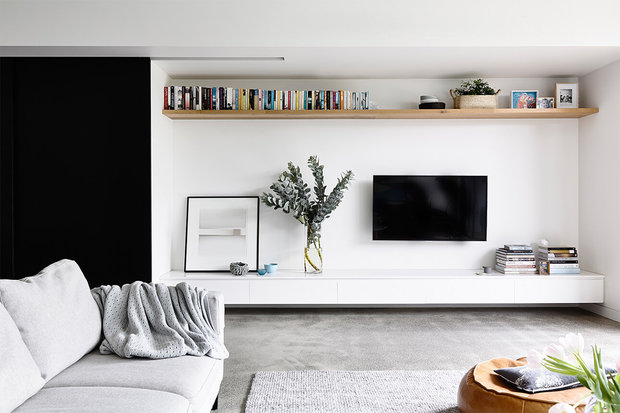
In the center of the room
If the living room is divided into several differently-functional areas, the logical question arises - how to design the TV zone in the room? A good option - to install a household appliance in the center of the room in the area that is intended for recreation. On the reverse side, the TV can be closed with a rack, a cabinet or a partition. Agree, the back of the device, put on public display, the aesthetics of the situation does not add.
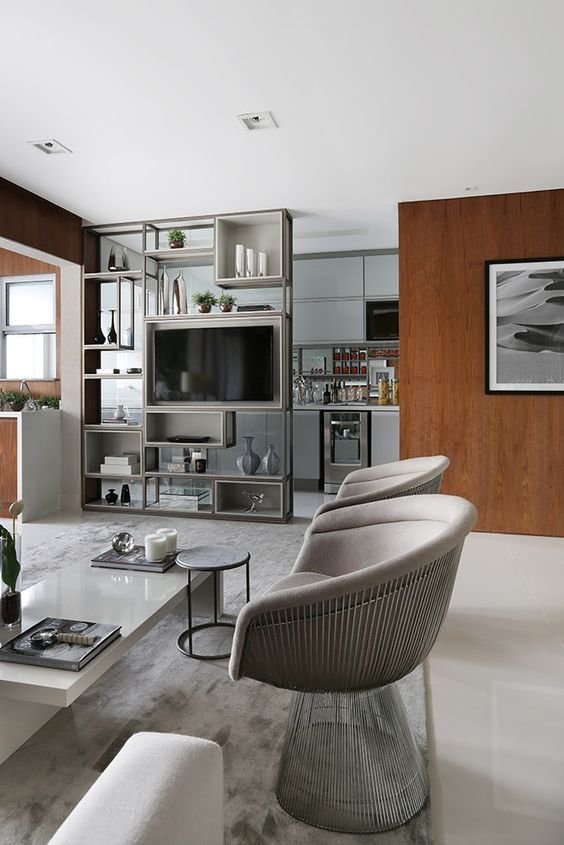
Not in front of the window
The location of the TV dictates the very arrangement of furniture in the room. First of all, decide from which point of the room (or several) you will watch it. It can be a sofa, a dining table, a working area of the kitchen, but other options are possible.
And one more important point: if the screen is on the opposite wall from the window, there is a high probability that it will shine and you will not see anything at all. The exit from this situation can be window shutters or tightly closing curtains with the effect of "blackout."
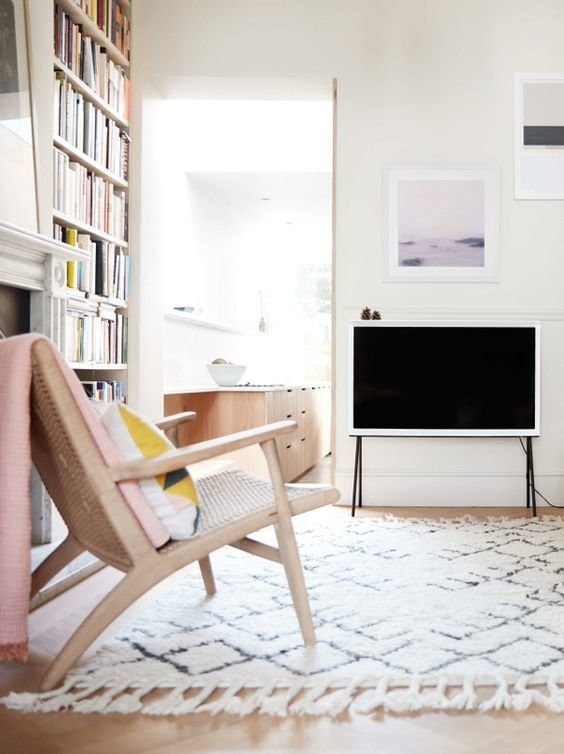
2. At what height do you need to hang up the TV?
If you are going to watch TV in the kitchen, say, standing at the stove, stand up with the imaginary (if you are still repairing) or the existing work surface, and then quickly look at the part of the wall where you plan to mount the television. The place where you looked (it will most likely be the level of your eyes or slightly lower / higher) must be remembered and immediately accurately fixed, say, shallow on the wall. The center of the monitor is supposed to be here.
The height of the location of the TV is also dictated by the position in which you intend to watch it. The standards in this regard are rather arbitrary, so there is nothing better than personal rechecking.
Precisely on the same principle, you can determine the comfortable height for the location of the TV on the wall in any room where it is supposed to be.
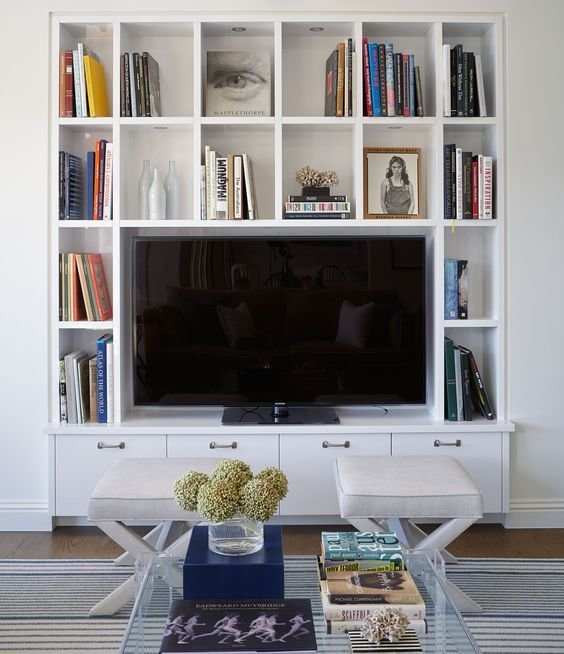
3. How to properly attach the TV to the wall?
If, in your planning, the location of the TV assumes its installation on a wall, you first need to check the technical feasibility of performing this operation. Remember: on a wall of drywall, you can not hang a heavy monitor. More than 30-35 kg, it can not withstand and risks simply collapsing.
Remember: on a wall of drywall, you can not hang a heavy monitor. More than 30-35 kg, it can not withstand and risks simply collapsing.
On the wall of brick or blocks, the monitor can be mounted using brackets. In this case, make sure beforehand that there is no wiring in the places where the dowels are supposed to be located.
Brackets can be either rigidly fixed or adjustable. In any case, we recommend choosing a mobile option. Who knows - suddenly you need to change the angle or slightly turn the screen in one direction or another.
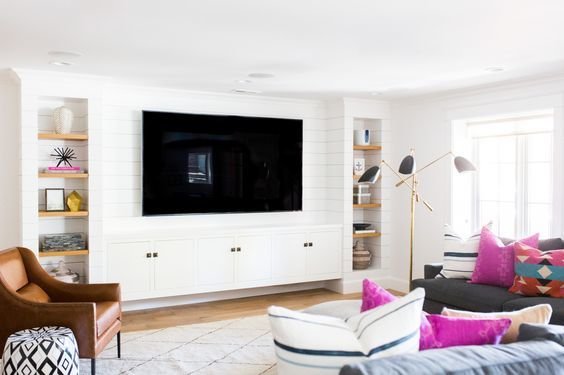
4. Where to hide wires and cables?
There are three most common options:
- Cable-channel. You can paste it with wallpaper or paint in the color of the walls to make it less noticeable.
- Strokes in the floor, wall, ceiling. Suitable only if you are sure that until the new repair will not change the location of the TV.
- Special furniture for TV with a thoughtful system of location and fixation of wires.
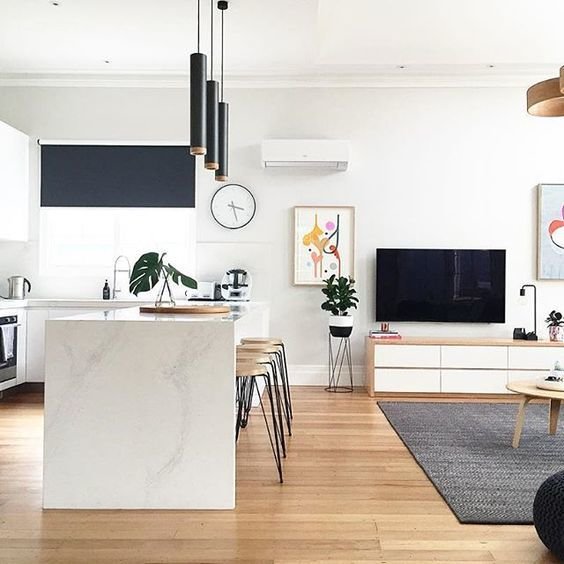
If your apartment is now in a state of repair
Pre-design and properly prepare the location of the TV and the corresponding conclusions for it. What you will need is necessary: 2 conventional sockets behind the monitor, 1 for the Internet and 1 television. In them you connect the plasma monitor itself, the tuner and / or the Wi-Fi adapter. All these outputs can safely be hidden behind the plasma monitor itself, by placing the outlets at a distance of 8-10 cm from the top or bottom edge of the monitor (as in your situation it will be more convenient).

If there is a TV stand next to the TV, on which other media equipment is supposed to stand, you will not be disturbed by the sockets behind it. At an altitude of 25-30 cm from the floor, place the unit on 4-5 outlets: even if you do not need them now, technologies are not worth it - it's better to spend a little now and protect yourself from unnecessary problems with wires, rosettes and transportations tomorrow.
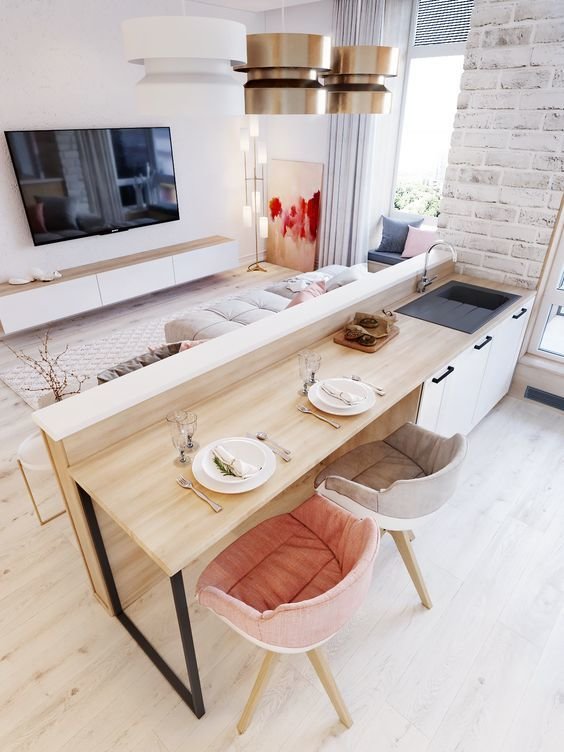
If the repair is already done
All the wires can be hidden in the cable-box and carefully brought it to the TV. Later, this box can be designed for the style of the wall on which it is located - in order to maximally disguise it.
In case the TV is located in front of the window and you decide to use the advice on curtains on the electric cornice, plan one more outlet under the ceiling in the place where such a curtain will hang (curtain specialists and an electrician will tell you more about this).
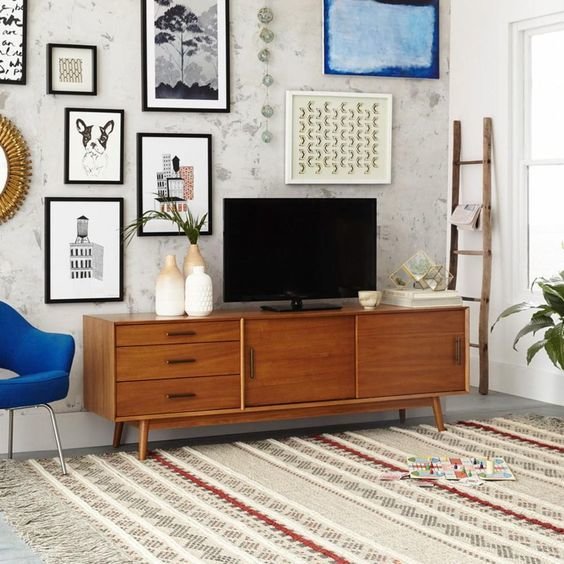
5. How to choose the size of the diagonal?
Many TV fans dream of a large plasma on half the wall. It is not difficult to buy such a TV, but before doing this, check how much the parameters of your room allow you to look at such a monitor without harm to your health.
The distance comfortable for the eyes from the monitor is 3-4 diagonals of the screen, in the case of liquid crystal monitors, 2-3 diagonals.
That is, a 40-inch TV should be viewed from a distance of 80-120 or 120-160 inches (1 inch is equal to 2.54 cm). Now you can calculate that the eyes of a person looking at a plasma 40 inches, should be located from it for 3-4 meters, and for LCD monitors - for 2-3 meters.
6. Do I need to arrange separate local lighting above the TV?
I answer: no, it is not necessary, because the glare from the lamp will interfere with the perception of images on the screen. However, it is not necessary to watch TV in complete darkness: the contrast of the bright screen and the total darkness of the surrounding space not only reduces the comfort of viewing, but also can negatively affect the vision.
Optimal option - muted background lighting. For example, a chandelier with a dimmer set to the minimum brightness. Or a few spots, a beam of light from which you can send a wall or corner. Also suitable are built-in miniature LED lamps that produce a dim light. Even local illumination of pictures or mirrors can successfully play the role of background lighting when watching TV.

Proper placement and good lighting affect the picture quality on your TV. Of course, if we are not talking about such ultra-modern devices as curved OLED TVs which will provide you with a beautiful image in any light and position in front of the screen.
But what if your TV is not equipped with innovative features and technologies? As it is correct, and most importantly, where, to put the TV?
1)
We do not recommend placing the TV at the window. The light from the window in combination with the light from the screen is very tiring of the eyes;
2)
Do not place the TV in front of the window. Direct sunlight, falling from the window to the screen, interferes with viewing;
3)
The height of the placement of the TV depends on the way it is viewed (lying / sitting), as well as on the purpose of the room in which the installation is planned. Often, the TV is hung at a height of 120 cm from the floor to the center of the TV. The universal rule is: hang the TV so that its upper third is at the level of your eyes while viewing;
4)
Do not cover the TV with napkins. It is not recommended to place on it objects of an interior, a life, and especially those which contain a liquid;
5)
Install the TV away from batteries and wet places;
6)
Most TVs "love" twilight. If you have good daylight, you need to think about the thick curtains on the windows.
7)
The distance from the TV should be 3-4 of its diagonals. In other words, a 40-inch TV will look right from 3 meters.
At what distance do you need to watch TV?
In order that the eyes do not get tired, and the withers do not "sit down" over time, at what distance do you watch TV. The distance depends directly on the diagonal of the TV. As described in the 7th paragraph - "The distance from the TV should be 3-4 of its diagonals.In other words, a 40-inch TV will look right from 3 meters,"below we gave a small table on the distance from the TV, depending on its diagonal.
Translated from CNET.com
Where the sun does not shine. Really.
No matter what size and type your TV is worth thinking about and where to place it best. Maybe the place where he always stood is not ideal for a television screen. Perhaps moving the TV with a small rearrangement of furniture will achieve a better image quality or make you decide to buy a model with a large screen.
Obviously, if you have a TV with a huge screen, then the options for its placement are rather limited. But maybe they will expand by rearranging furniture?
Before placing a 22-inch LCD in a corner of the room under the ceiling or an 84-inch 4K screen in the middle of the room, listen to the following tips.
Pay attention to...
The height of the screen. Although there are no special recommendations for placing the TV in height, ideally you do not want to set it too high. In order to always look at the screen, as if sitting in the first row of the cinema. This is not very convenient, especially in the case of long sessions, not to mention the possible limitations of vertical viewing angles. Generally speaking, it is desirable that the center of the TV screen be approximately at eye level, or even slightly lower. This should also be taken into account in case of wall mounting, and not only when using the display on a desktop stand.
Distance from the screen. It's unlikely you're going to sit too close to the TV. Most people range from the screen at a distance of about three meters, from which it is already impossible to see the difference between 1080p and 720p TVs, for most screen sizes. Located closer to the screen, you get two main advantages. The field of view widens, so that what is happening on the screen becomes more exciting, and you can see additional details of the image, especially at higher resolution of the display. If you can not or do not want to sit close to the screen, then you can think about buying a new TV with a larger diagonal.
Check the placement. Lighting the room and reflecting light sources are the main culprits for deteriorating the quality of TV images. Although, almost everyone modern TV has an anti-reflective coating of the screen, do not expect miracles from it, its possibilities are not unlimited. Of course, you can simply turn off the lights or tighten the curtain more tightly, but sometimes it's not so simple or even impossible.
If you prefer wall mount TV, still keep in mind all the above mentioned features. And additionally, if you have a liquid crystal display, make sure that the wall mount used will allow you to rotate or adjust the position of the screen. With rare exceptions, the quality of the LCD display deteriorates if you move away from the center of the screen. The ability to rotate the screen so that it is directly in front of your eyes will allow you to make serious progress in image quality (compared to a similar TV that is not aimed at you). It is worth noting that today's TVs are light enough that it simplifies the reliable wall mount even for large enough displays.
Take into account the style. Modern TV models often stand out with original desktop supplies, but, depending on the design, they are not always turning. Whichever style you like, most of the stands have almost the same height, a few centimeters above or below the ideal - it does not really matter, but the big screen on the high stand is clearly not looking.
Ensure safety. It turns out that falling and traumatizing TVs are not a rare phenomenon. Be sure to securely secure or position your TV so that it does not fall, especially if you have children or pets.
Do not set the TV up too high. When you stand, the TV screen may seem to be located really low, but it will look great when you sit in front of it, because most of the time you will not stand when watching TV.
Do not install the TV above the fireplace, for the reason stated above.
Do not install the TV outdoors (in the garden, ...). There are TVs made specifically for outdoor use. If you do not want to spend money on a TV set for outdoor use, just know that any home TV left on the street probably will not last long (even if it's under a canopy). It's best to bring it into the house when you do not use it.
Do not sit too far from the screen. However, in order to compensate for the distance you can buy a model with a larger diagonal.
Do not set the TV so that you have to look at the screen in an uncomfortable position. If you have to sit for a while throughout the movie, turning your head constantly, it will simply lead to a strain on the muscles of your neck. Although a small turn of the head may not seem like much of a problem, but keeping this position for several hours, you can feel the pain literally.
conclusions
Let's look at two rooms as an example. In the first case, there is a TV with a large screen fixed high in the corner of the room, and in the other corner there is a sofa for spectators and a series of lighting lamps. These unfortunate viewers will receive a visually seemingly small screen, a mass of reflections from the light sources and tension for the neck muscles due to the constantly pointed upward view.
Second room: The TV is located at eye level, the sofa is about three meters away from the screen, the adjustable light source provides soft lighting in the room.
In which room is it more pleasant to watch a fascinating film?
Optimal placement of a new TV will eliminate a number of problems associated with optimizing image quality and comfortable viewing conditions. Not only do you get the optimal image for viewing in a comfortable environment, but when solving this problem you can still free up space for other things.
The living room is the place where the whole family gathers in the evening, rests behind conversations and watching interesting films.
When placing the TV in the living room, where there is a lot of space, it should be remembered that it should belarge enough, otherwise you will have to look at the image. In living rooms, the size of which is severely limited, it is better to place TVs of small size, otherwise because of a breach of perspective due to a small distance, the head may be dizzy.
Choosing a place for a TV, you must proceed from the fact that you place it in such a way that sunlight does not get on the TV screen, which can significantly degrade the quality of the picture due to the shadows. The window behind the TV can be, but on the side of it, especially if the room is on the sunny side, no.
Opposite the sofa you need to put chairs with comfortable high soft armrests, otherwise you will not be able to relax. Perhaps, furniture without armrests looks more stylish, but first of all it is better to take care of comfort.
In addition to complying with the distance, it is worth remembering the angle of view. For conventional TVs, it should not be less than 30 degrees, for 3D-TVs other rules, it is better to clarify in advance.
The same applies to the location of the TV on the wall or bracket in relation to the level of the eyes. Optimal is the straight line drawn from them to the center of the screen. If the TV is fixed above, it is advisable to make sure that the angle from this line does not exceed 30 degrees. This is the rule for optimally comfortable hours of hours in front of the TV without harm to the eyes, many of it violate without feeling uncomfortable.
Before deciding to fix the TV on the living room wall, it is worth considering how much additional equipment will be connected to it (speakers, DVD player, game console, cable) and where to hide all these wires. Perhaps, the more optimal solution is to put the TV on a narrow TV-box or to integrate into a furniture set. Or, take care of the wall in advance.
There are principles a grouping of armchairs and sofas in front of the TV.
First - a sofa in the center of the monitor, chairs - on the sides or along the wall - more common.
The second is the placement of the sofa in front of the TV.
The third - an armchair and a sofa opposite each other, and the TV is in the center. Haveis good for a small living room, especiallysquare shape. Rectangular Living Room The room with the TV can be zoned with a sofa, which is turned across the room. In this case, you can put a rack to the back, which will further emphasize the division into individual zones. If the seats are too small and the chairs look too massive, you can resort to such an element as ottomans. They are not only aesthetic, but also incredibly comfortable. In addition, they can be placed anywhere, they do not overload the interior.
Between the sofa and the TV you can place a smallcoffee table, the best glass. It looks airy and elegant.
If the living room is made in bright colors, on the background of which the TV looks like a big black spot, you can soften this imbalance by changing the color of the wall in which it is located. For example, you can use contrasting colors to those used in the interior, or, if the room is made in the same scale, highlight the wall with a hue, three shades darker than the main one.
Elegantly fit the TV into the living room with pictures in the frames, creating a composition centered on TV. Or around the TV set several rows of hanging shelves with trinkets. Using this technique, the main thing is not to overdo it, so as not to be distracted by them while watching.
In the interior of the living room of a classic style, a modern TV can seem like a foreign body. To change this feeling, you can place next to him something big, distracting attention to yourself - an outdoor vase or a tree in a pot. If there is a fireplace in such an interior, then the best place for TV is above the fireplace, because it is he who will play the role of a distracting element and draw attention to himself. If nothing distracting comes to mind, and the TV is too much knocked out of the interior, you can just hide it, as in the example below.
![]()
